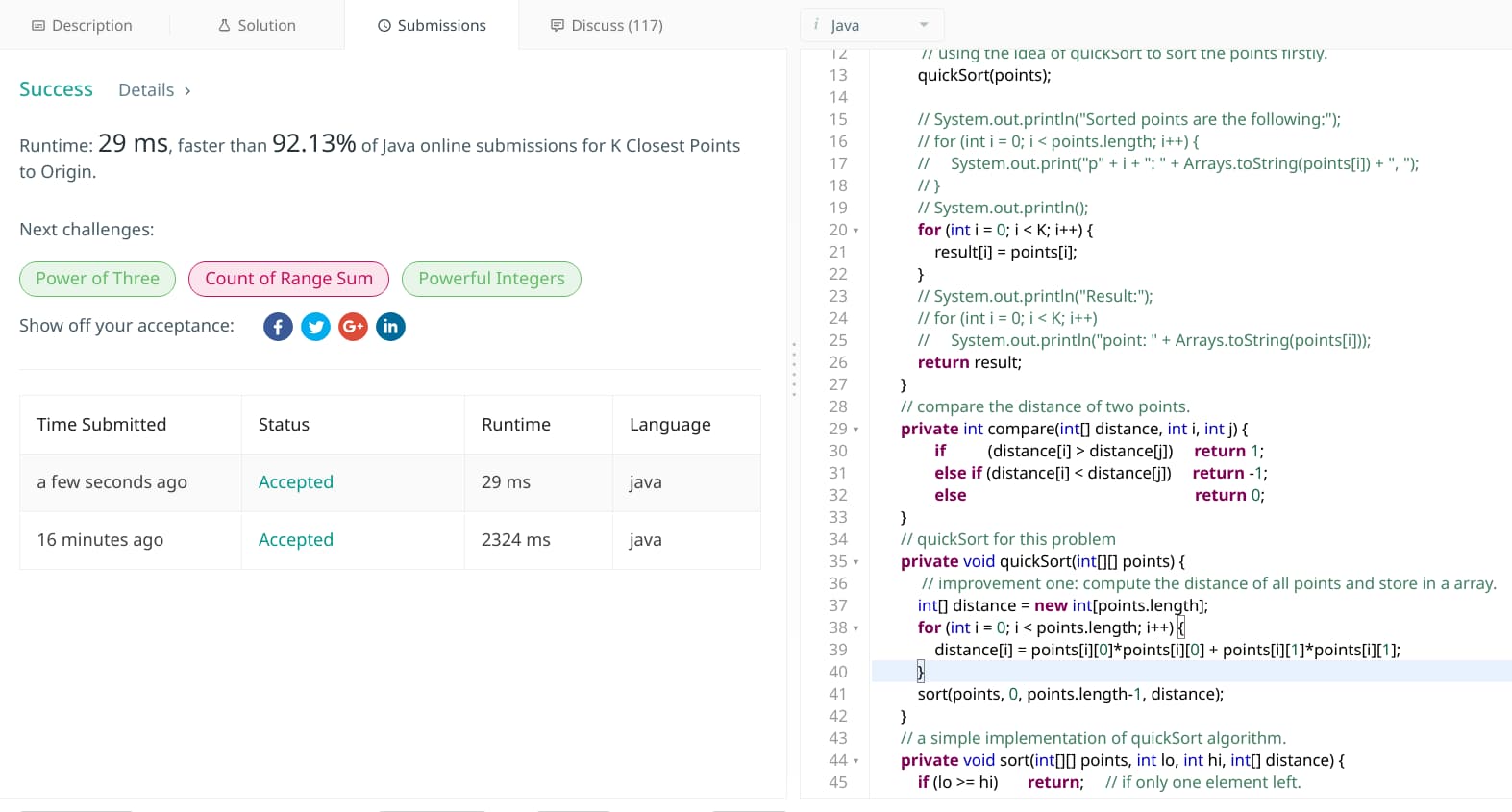0973.K Closest Points to Origin
Description
We have a list of points on the plane. Find the K closest points to the origin (0, 0). (Here, the distance between two points on a plane is the Euclidean distance.) You may return the answer in any order. The answer is guaranteed to be unique (except for the order that it is in.)
Example 1:
Input: points = [[1,3],[-2,2]], K = 1
Output: [[-2,2]]
Explanation:
The distance between (1, 3) and the origin is sqrt(10).
The distance between (-2, 2) and the origin is sqrt(8).
Since sqrt(8) < sqrt(10), (-2, 2) is closer to the origin.
We only want the closest K = 1 points from the origin, so the answer is just [[-2,2]].
1
2
3
4
5
6
7
2
3
4
5
6
7
Example 2:
Input: points = [[3,3],[5,-1],[-2,4]], K = 2
Output: [[3,3],[-2,4]]
(The answer [[-2,4],[3,3]] would also be accepted.)
1
2
3
2
3
Note
1 <= K <= points.length <= 10000
-10000 < points[i][0] < 10000
-10000 < points[i][1] < 10000
1
2
3
2
3
Links
(en)https://leetcode.com/problems/k-closest-points-to-origin
(中文)https://leetcode-cn.com/problems/k-closest-points-to-origin
Solutions
Solution1
题目要求是找到离原点(0,0)最近的前K个点,因此最简单直接的想法是将points按点到原点的距离从小到大排序,返回前K个点即可。
思路
由于是数组排序,优先考虑快排(利用快排的思想实现, 只是简单的基本快排,没有任何优化处理) 可以试着尝试快排优化:
- 切换排序方式: 当待排序数组元素少于一定数量时,快排序效率反而低,此时可以切换成插入排序等;
- 随机选择基准元素(povit): 基本的快排每一轮排序都是选择当前待排序数组的最左边元素作为基准元素;
- 三路快排(熵最优): 区别于一般快排,它将待排序数组分成是三个部分, 即小于基准元素部分、等于基准元素部分、大于基准元素的部分,递归排序第一和第三部分。适用于待排序数组中拥有重复元素较多的情况.
Java Code
我解题时的线上提交代码:
class Solution {
/*
Approach One: using the idea of quickSort to sort the given array {@code points} firstly.
Complexity Analysis:
TC: O(n log n)
SC: O(1)
*/
public int[][] kClosest(int[][] points, int K) {
if (K >= points.length) return points;
int[][] result = new int[K][2];
// using the idea of quickSort to sort the points firstly.
quickSort(points);
// System.out.println("Sorted points are the following:");
// for (int i = 0; i < points.length; i++) {
// System.out.print("p" + i + ": " + Arrays.toString(points[i]) + ", ");
// }
// System.out.println();
for (int i = 0; i < K; i++) {
result[i] = points[i];
}
// System.out.println("Result:");
// for (int i = 0; i < K; i++)
// System.out.println("point: " + Arrays.toString(points[i]));
return result;
}
// compare the distance of two points.
private int compare(int[] distance, int i, int j) {
if (distance[i] > distance[j]) return 1;
else if (distance[i] < distance[j]) return -1;
else return 0;
}
// quickSort for this problem
private void quickSort(int[][] points) {
// improvement one: compute the distance of all points and store in a array.
int[] distance = new int[points.length];
for (int i = 0; i < points.length; i++) {
distance[i] = points[i][0]*points[i][0] + points[i][1]*points[i][1];
}
sort(points, 0, points.length-1, distance);
}
// a simple implementation of quickSort algorithm.
private void sort(int[][] points, int lo, int hi, int[] distance) {
if (lo >= hi) return; // if only one element left.
int povit = lo;
int l = lo;
int h = hi + 1;
while (true) {
while ( compare(distance, povit, ++l) > 0) {
if (l == hi) break;
}
while ( compare(distance, povit, --h) < 0) {
if ( h == lo) break;
}
if (l >= h) break;
swap(points, distance, l, h);
}
swap(points, distance, lo, h);
sort(points, lo, h-1, distance);
sort(points, h+1, hi, distance);
}
// swap two points and their distance.
private void swap(int[][] points, int[] distance, int i, int j) {
// swap two points.
int[] temp = points[i];
points[i] = points[j];
points[j] = temp;
// swap their distance.
int dis = distance[i];
distance[i] = distance[j];
distance[j] = dis;
}
}
1
2
3
4
5
6
7
8
9
10
11
12
13
14
15
16
17
18
19
20
21
22
23
24
25
26
27
28
29
30
31
32
33
34
35
36
37
38
39
40
41
42
43
44
45
46
47
48
49
50
51
52
53
54
55
56
57
58
59
60
61
62
63
64
65
66
67
68
69
70
71
72
73
74
2
3
4
5
6
7
8
9
10
11
12
13
14
15
16
17
18
19
20
21
22
23
24
25
26
27
28
29
30
31
32
33
34
35
36
37
38
39
40
41
42
43
44
45
46
47
48
49
50
51
52
53
54
55
56
57
58
59
60
61
62
63
64
65
66
67
68
69
70
71
72
73
74
Submission status
